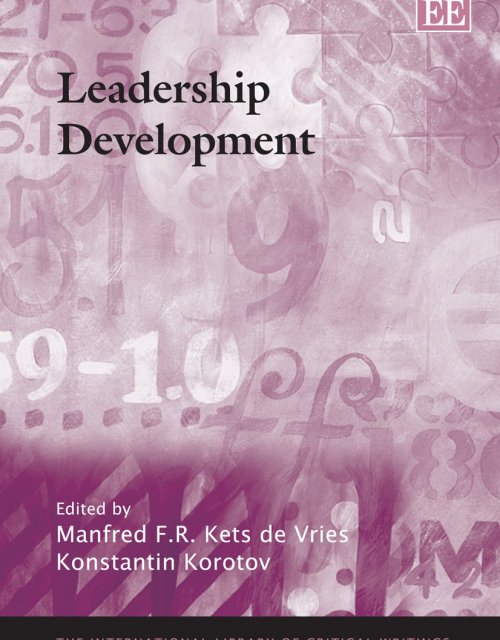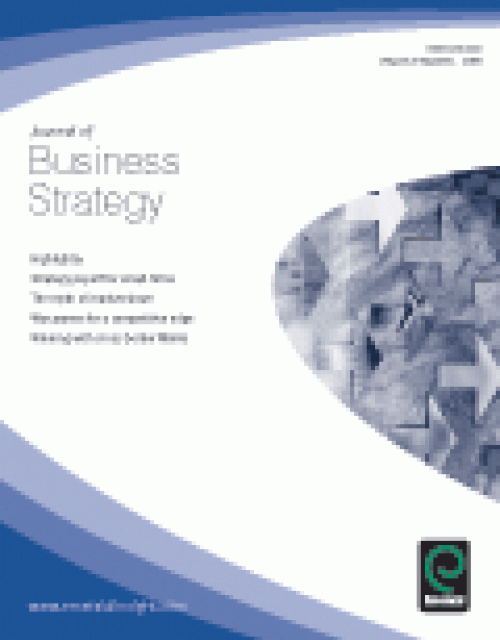Publication records
Subject(s)
Human resources management/organizational behavior; Strategy and general management
Keyword(s)
Leadership development, leadership, academic writings on leadership development
This authoritative volume brings together a critical selection of important academic articles and practitioner-oriented papers that reflect current thinking and practices in the growing field of leadership development. It offers a solid foundation for theoretical approaches to leadership development and covers the key methodologies applicable to leadership development research and practice. This indispensible collection is edited by two leading authorities in the field and features an original introduction. It will be an essential source of reference for scholars, students and practitioners in the fields of leadership, leadership development, human resource management and education. 36 articles, dating from 1952 to 2009.
Pages
672
ISBN
978–1–84844–827–8
Subject(s)
Economics, politics and business environment
Keyword(s)
market definition, shopping centre, externalities, characteristics approach
Based on some recent decisions of national European competition authorities and courts, we analyze how the choice of methodology impacts the product market definition in the shopping center industry. Relying only on product characteristics and existing industry classifications disregards actual substitutability patterns and may likely lead to market definitions that are too narrow. Ignoring the effects of externalities common in the industry has similar effect. Market definition should take these features into account.
Pages
52
ISSN (Print)
1866–4016
Subject(s)
Strategy and general management
Keyword(s)
arts, leadership, leadership projection, story telling
Purpose - The paper "Made in heaven - produced on earth: creative leadership as art of projection" is about the concept of projection in the context of leadership.
Design/methodology/approach - This article takes a close look at Jeff Koons, a successful and highly controversial contemporary artist. The paper explores the way in which storytelling linked to his artwork has been the key element of the way he has projected himself as a credible leader in the world of contemporary art.
Findings - This article examines how the artist Koons is using the three universal story lines used by leaders to excite and gain buy-in from an audience as described by the sociologist Howard Gardner: (1) who am I - How life experience has shaped my individuality and character; (2) who are we - Demonstrate the values and behaviors of a group; and (3) where are we going - Explains what is new, and creates a sense of excitement about direction. The authors find that throughout his career and his various artistic production cycles like the inflatables, the New, Equilibrium, Luxury Degradation, Statuary, Kiepenkerl, Banality, Made in Heaven, Puppy, Celebration, Easyfun, Popeye, and Hulk Elvis, Jeff Koons is using key elements of the art of projection by linking his art work to the three universal story lines who am I, who are we, and where are we going. A closer analysis of Koons' work reveals how he has leveraged each of these dimensions of effective storytelling as a broad narrative to link his various series together as a consistent whole.
Practical implications - The authors suggest that Koons' use of storytelling, and the manner in which he has come to embody the themes and concepts that he seeks to communicate through his artworks, present powerful lessons for managers as to how they can manage their own leadership projection. By looking at Koons, managers can better understand not only how to establish credibility and drive buy-in, but also how to project themselves as leaders in their respective fields of business endeavor.
Originality/value - While there is literature on the art of storytelling there has been less focus on the sphere of art and how artists use storytelling and projection to take their audience with them. This new perspective not only creates new insights on the concept of storytelling and potential future research but has implications for managers and leaders and the way they want to drive change in organizations and take people on their managerial journey.
With permission of Emerald Insight
Volume
32
Journal Pages
12–24
Subject(s)
Strategy and general management
Keyword(s)
competitive strategy, low-cost competition, low-frills products, reverse innovation, sales, China, Siemens, market entry
The case is set in November 2007. Matthias Rebellius, head of the business unit fire safety and security products, has to make a decision about the China strategy for the fire systems unit. Siemens has a very strong position globally in fire systems. Especially in developed markets, in the so-called M1 segments, Siemens is often number one or two. But worldwide and especially in China, the so-called M2 and M3 markets (Siemens terminology) had strong growth, but Siemens was not very well positioned in these segments of the market.
The case begins with a short introduction outlining the situation. It then gives a detailed background on Siemens, especially the operating division Building Technologies (BT), and within BT the business unit Fire Safety & Security Products (FS). The case illustrates that the BT division was mainly active in mature, developed markets with slow growth rates. At the same time, there was an aggressive goal of achieving annual growth rates of more than five percent with an EBIT margin of 7 to 10 percent.
| buy now | buy now | buy now |
Subject(s)
Human resources management/organizational behavior
Keyword(s)
coaching, psychological safety, leadership development
Volume
7–8
Journal Pages
56–57
Subject(s)
Human resources management/organizational behavior
Keyword(s)
differences, leadership, Russia, European Union
Subject(s)
Finance, accounting and corporate governance
Keyword(s)
bank lending channel, loan supply, consumer lending, credit rationing, relationships
JEL Code(s)
G01, G21, F34
This paper examines the broader effects of the U.S. financial crisis on global lending to retail
customers. In particular we examine retail bank lending in Germany using a unique dataset of
German savings banks during the period 2006 through 2008 for which we have the universe of
loan applications and loans granted. Our experimental setting allows us to distinguish between
savings banks affected by the U.S. financial crisis through their holdings in Landesbanken with
substantial subprime exposure and unaffected savings banks. The data enable us to distinguish
between demand and supply side effects of bank lending and find that the U.S. financial crisis
induced a contraction in the supply of retail lending in Germany. While demand for loans goes
down, it is not substantially different for the affected and non-affected banks. More importantly,
we find evidence of a significant supply side effect in that the affected banks reject substantially
more loan applications than non-affected banks. This result is particularly strong for smaller and
more liquidity-constrained banks as well as for mortgage as compared to consumer loans. We
also find that bank-depositor relationships help mitigate these supply side effects.
With permission of Elsevier
Volume
100
Journal Pages
556–578
Subject(s)
Marketing
Keyword(s)
return on marketing
Volume
28
Journal Pages
8–12
Subject(s)
Finance, accounting and corporate governance
Keyword(s)
managerial accounting, cost center accounting, contribution margins

